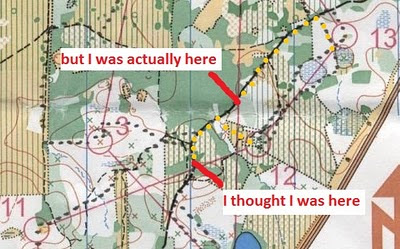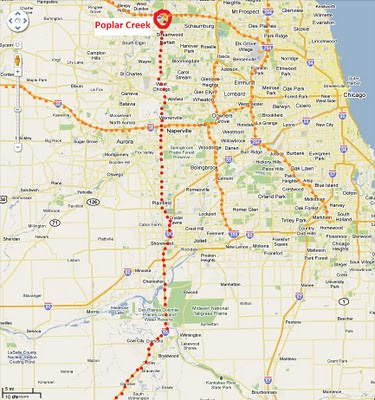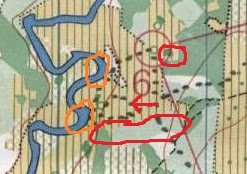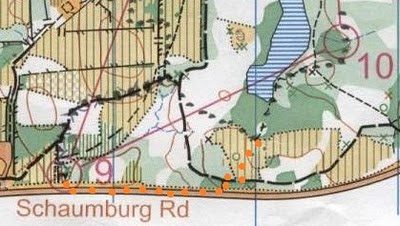Poplar Creek marks my first orienteering experience since my college life. Two years ago on November, I was with a person from UI to attend an orienteering event in Poplar Creek because he liked orienteering, and I was also interested in this. I even brought two more people from Chicago to come, with one of them my friend and another person my friend’s friend. I remembered that day was cold with flurries. I also remembered that I did the Green course (advanced short course) for my first time in orienteering, and I managed to finish it. By that time, I was very confident with my map reading skills, and I had no fear to run into woods. Perhaps I already liked orienteering when I was young. It was just that I did not find the correct opportunity to do it.
Now I came back to this place once again. This place was far northwest of Chicago. I once again did not use I-57 to go to Chicago area and use IL-47 instead. Then, I used I-55 and then drove IL-59 all the way from the south to the north. This avoided all the toll highways (I-88 and I-90).
I continued to do the hardest and longest Red course. The map, the clue sheet, and my results are shown below. The map is huge so I decided to scan only the area with the course. The clue sheet is scanned separately.
From my last Poplar Creek experience, this location has many open areas with a lot of tall grass. The grass certainly will slow down people in running these areas.
I met Richard Gaylord, the course setter who designs the route of the orienteering race, at the start point. He was experienced in orienteering. When I mentioned my interest in organizing an orienteering event in Champaign, he told me his experience ~30 years ago when he did orienteering in central Illinois area. He was amazed with the terrain. He would even like to bring his old maps to me next time we meet.
Rich set the course such that all control points were on the south side of Golf Road. This action was to avoid the participants from crossing a road where vehicles travel 50 MPH (80 km/h). Because of this, to me it was the first time that the registration and the start/end point were at separate places (see map above).
After I finished this course, I felt that I made so many mistakes. One orienteering term in my mind is “parallel error”. Nevertheless, it was better than last time in Waterfall Glen East (see here) that I lost almost an hour for finding 2 controls.
The followings are my review on each control:
Start à 1: I already made an error in the first leg. My plan was to run the trail to a marsh. Then I used the marsh to maintain the approximate running direction, so that I would hit the open land. Finally, I used the boundary between white wood (easy running) and yellow open land and got close to Control #1.
What actually happened, however, was that I knew I ran too far because I saw another open land ahead. However, I wanted to find where the first open land ended because that point was the closest feature to control #1 (see map below). I walked back in general direction, not completely aimless but also not having accurate bearing, and searched for the control. Fortunately, I found the control when I walked back.
1 à 2: I think I did well on this one. I ran back to the trail and followed the trail until I got close to the white wood. Then I ran into the forest and found the control.
2 à 3: Use the trail and then go west into the wood. Notice the contours to locate the hill. No problem with this leg, either.
3 à 4: I had to make some decisions for reaching this control -- I could set my bearing straight to control #4, but I would pass through the wood in dark green (difficult to walk through). The other option was to go west to the open land so that I could move faster than in the woods. In the end, I took a detour to the open land on the west, and then went back east to another open land. From there I used the compass to point to the control #4 direction to run.
| The east open land on the way to Control 4, looking east |
After finishing the course, I talked to Richard about how I progressed to each control. For this control, he commented that perhaps it would be faster if I ran the trail on the west open area until control #4 was east of me. Then I went east into the white wood and got to the control. That was a good suggestion after I thought about this.
 |
| Blue: straight line route, Black: my route, Orange: Richard's suggestion, Red arrow: Picture taking location and direction of the above picture |
4 à 5: Nothing too special. I used the trail, then I used the compass bearing where the trail ended. I found the control without any difficulty.
5 à 6: Error number 2! I considered myself making a parallel error on this one. A parallel error means that a person think that one has reached the feature (e.g. a bend of a stream, a distinct tree), but one actually reaches the wrong feature because the correct feature is close to the wrong but similar feature (e.g. at the wrong bend of the stream segment).
My parallel error occurs when I got close to control #6. I looked at the wrong vegetation boundary. This area had a lot of tall grass, and it was quite difficult to walk over grass. There were some trees in the middle of this open land, which I might assume these trees would be drawn on the map as “distinct trees”. Moreover, I had to visit the river on the west to count the number of bends. With these clues, I finally recognized my location and found the control #6.
| Tall grass |
6 à 7: Compass bearing helped me enough to find Control #7.
7 à 8: A lot of running across the grassy open field. There was a dry stream that I could follow and pass through the green wood. Then I reached another open land and found control #8.
8 à 9: Running through the trail almost all the way.
9 à 10: The trails can be used for the most part until I got close to the control, where compass bearing was used. After finishing the course, Richard suggested that I could also run along Schaumburg Road so that the running distance could be shortened. How come I did not think about that!
10 à 11: It was once again a compass bearing exercise for me.
11 à 12: Error number 3! Perhaps I was off-guard by this control, thinking that the major trail that I previously passed through to control #2 should readily locate myself. Therefore, I ran east without thinking much until I hit the major trail. However, I identified myself on the trail at the wrong place. This was another parallel error. I used the bending of the trail to identify my location, but I incorrectly locate the bend. The result: I went to a big marsh after going off-trail. I was confused for a minute and then realized that I was close to control #13 rather than control #12. Time was wasted in going back to Control #12.
 |
| Yellow dots show my plan to approach Control #12. I should get off trail after the trail bends right. However, I did not estimate my starting position on trail correctly, so a big mistake was made. |
12 à 13: Using compass and marshes to lead me back to Control #13.
13 à 14: Running along the vegetation boundary and then using the compass and surrounding contours to lead to control #14.
14 à finish: Running mostly on trail.







No comments:
Post a Comment